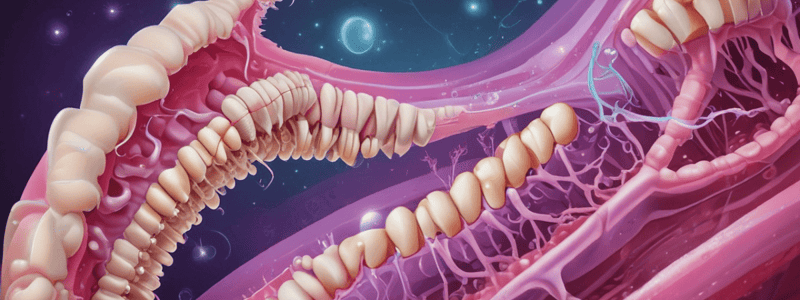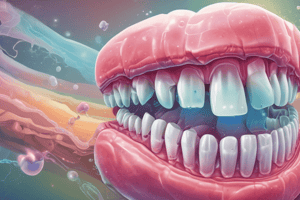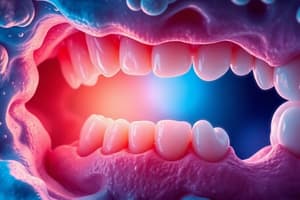Podcast
Questions and Answers
What is the primary source of inorganic constituents in supragingival dental plaque?
What is the primary source of inorganic constituents in supragingival dental plaque?
- Saliva (correct)
- Gingival crevicular fluid
- Food particles
- Blood plasma
What is the function of glycoproteins and proline-rich proteins in the pellicle?
What is the function of glycoproteins and proline-rich proteins in the pellicle?
- To destroy bacteria
- To harden the tooth surface
- To serve as attachment sites for bacteria (correct)
- To provide nutrients to bacteria
What is the difference between adhesion and attachment of bacteria in dental plaque formation?
What is the difference between adhesion and attachment of bacteria in dental plaque formation?
- Adhesion occurs in hours, while attachment occurs in days
- Adhesion is weak and reversible, while attachment is strong and irreversible (correct)
- Adhesion occurs in minutes, while attachment occurs in hours
- Adhesion is strong and irreversible, while attachment is weak and reversible
What is the purpose of co-adhesion in dental plaque formation?
What is the purpose of co-adhesion in dental plaque formation?
What is the trend observed in the shift from facultative gram-positive to anaerobic gram-negative bacteria during dental plaque maturation?
What is the trend observed in the shift from facultative gram-positive to anaerobic gram-negative bacteria during dental plaque maturation?
What is the primary source of organic constituents in dental plaque?
What is the primary source of organic constituents in dental plaque?
How long does it take for colonization and plaque maturation to occur?
How long does it take for colonization and plaque maturation to occur?
What is the function of the pellicle in dental plaque formation?
What is the function of the pellicle in dental plaque formation?
What type of forces are involved in the initial adhesion of bacteria to the pellicle?
What type of forces are involved in the initial adhesion of bacteria to the pellicle?
What is the primary source of inorganic constituents in subgingival dental plaque?
What is the primary source of inorganic constituents in subgingival dental plaque?
What type of plaque is located above the gingival margin?
What type of plaque is located above the gingival margin?
What type of bacteria are generally found in super gingival plaque?
What type of bacteria are generally found in super gingival plaque?
What is the trend observed in the layers of plaque as it grows out from the tooth surface?
What is the trend observed in the layers of plaque as it grows out from the tooth surface?
What is unique about the sub gingival plaque compared to super gingival plaque?
What is unique about the sub gingival plaque compared to super gingival plaque?
What is the difference between super gingival and sub gingival plaque?
What is the difference between super gingival and sub gingival plaque?
What type of bacteria thrive in the sub gingival region?
What type of bacteria thrive in the sub gingival region?
What is the direction of plaque growth from the tooth surface?
What is the direction of plaque growth from the tooth surface?
What is the characteristic of the early layers of plaque that are directly attached to the tooth?
What is the characteristic of the early layers of plaque that are directly attached to the tooth?
What primarily consists of glycoproteins, purine-rich proteins, and inorganic molecules?
What primarily consists of glycoproteins, purine-rich proteins, and inorganic molecules?
What type of bacteria are the primary early colonizers?
What type of bacteria are the primary early colonizers?
What do secondary late colonizers tend to feed on?
What do secondary late colonizers tend to feed on?
What is the function of Fusobacterium?
What is the function of Fusobacterium?
What is the term for the communication among bacteria in the biofilm?
What is the term for the communication among bacteria in the biofilm?
What is the benefit of quorum sensing in the biofilm?
What is the benefit of quorum sensing in the biofilm?
What is the characteristic of biofilm bacteria that makes them more resistant to antimicrobial agents?
What is the characteristic of biofilm bacteria that makes them more resistant to antimicrobial agents?
What is the term for the fluid channels that run through the plaque mass?
What is the term for the fluid channels that run through the plaque mass?
What is the term for the group of living microorganisms that includes the pellicle, primary colonizers, and secondary colonizers?
What is the term for the group of living microorganisms that includes the pellicle, primary colonizers, and secondary colonizers?
What is the characteristic of planktonic bacteria compared to biofilm bacteria?
What is the characteristic of planktonic bacteria compared to biofilm bacteria?
What is the arrangement of microbe complexes in the image similar to?
What is the arrangement of microbe complexes in the image similar to?
Which complexes are considered high priority for the board exam?
Which complexes are considered high priority for the board exam?
What is the red complex associated with?
What is the red complex associated with?
What is the purpose of the orange complex?
What is the purpose of the orange complex?
What is the name of the bacteria that causes gingivitis?
What is the name of the bacteria that causes gingivitis?
What is the ecological plaque hypothesis?
What is the ecological plaque hypothesis?
What is the significance of the tooth surface in the image?
What is the significance of the tooth surface in the image?
Which of the following bacteria is NOT part of the red complex?
Which of the following bacteria is NOT part of the red complex?
What is the purpose of remembering the 'peas' and 'T's' in the red complex bacteria?
What is the purpose of remembering the 'peas' and 'T's' in the red complex bacteria?
What is the correct order of the plaque hypotheses?
What is the correct order of the plaque hypotheses?
Which bacterium causes aggressive periodontitis?
Which bacterium causes aggressive periodontitis?
Which bacterium is associated with healthy gingiva but can also cause root caries?
Which bacterium is associated with healthy gingiva but can also cause root caries?
Which of the following bacteria is a bridge microorganism?
Which of the following bacteria is a bridge microorganism?
Which bacterium is known to cause chronic periodontitis?
Which bacterium is known to cause chronic periodontitis?
Which bacterium is associated with pregnancy gingivitis?
Which bacterium is associated with pregnancy gingivitis?
Which bacterium is most commonly known to cause acute necrotizing form of either gingivitis or periodontitis?
Which bacterium is most commonly known to cause acute necrotizing form of either gingivitis or periodontitis?
Which bacterium is notorious for causing coronal caries?
Which bacterium is notorious for causing coronal caries?
Which bacterium is one of the most common oral bacteria and resides mostly on the tongue?
Which bacterium is one of the most common oral bacteria and resides mostly on the tongue?
Flashcards are hidden until you start studying
Study Notes
Plaque Composition
- Two main types of plaque regions: Supragingival (above the gingival margin) and Subgingival (below the gingival margin)
- Supragingival plaque:
- Bacteria are generally aerobic
- Early layers of plaque tend to be Gram-positive
- Outer layers tend to be Gram-negative
- Subgingival plaque:
- Bacteria are generally anaerobic
- Gram-negative bacteria tend to accumulate in both early and later layers
- Gram-positive bacteria are present in early layers, but decrease in later layers
Plaque Formation
- Initial step: Formation of pellicle within seconds of tooth cleaning
- Consists of glycoproteins, proline-rich proteins, and other molecules that serve as attachment sites for bacteria
- Not harmful by itself, but provides attachment sites for bacteria
- Second step: Adhesion and attachment of bacteria within minutes
- Initial adhesion is weak and reversible, due to Vander Waals and electrostatic forces
- Firm attachment is strong and irreversible, due to specific bacterial adhesion molecules and receptors provided by pellicle
- Third step: Colonization and plaque maturation within 24-48 hours
- Firmly attached primary colonizers provide new receptors for attachment of other bacteria
- Shift from Gram-positive to Gram-negative bacteria as plaque grows and matures
Plaque Maturity
- Mature plaque is a biofilm, consisting of fluid channels that permit passage of nutrients and waste products
- Quorum sensing: communication among bacteria in biofilm to encourage growth of beneficial species and discourage growth of competing species
- Biofilm bacteria are more resistant to antimicrobials than planktonic bacteria
Microbial Complexes
- Different colors and names are associated with different microbial complexes (e.g. blue complex, yellow complex, orange complex, red complex)
- Red complex bacteria (P. gingivalis, T. denticola, and T. forsythia) are associated with periodontal disease and are important to know for the board exam
- Orange complex bacteria (F. nucleatum, P. intermedia, and S. rectus) precede the presence of red complex bacteria and support the sequential nature of plaque maturation
Major Bacteria to Know
- Aggregatibacter actinomycetemcomitans (Aa): causes aggressive periodontitis
- P. gingivalis: causes chronic periodontitis
- T. denticola: causes acute necrotizing gingivitis or periodontitis
- T. forsythia: associated with periodontal disease
- P. intermedia: influences pregnancy gingivitis
- F. nucleatum: orange complex bacteria, bridge microorganism
- Actinomyces: associated with healthy gingiva, can cause root caries
- S. mutans: notorious for causing coronal caries
- S. salivarius: one of the most common oral bacteria, resides mostly on the tongue
Studying That Suits You
Use AI to generate personalized quizzes and flashcards to suit your learning preferences.




